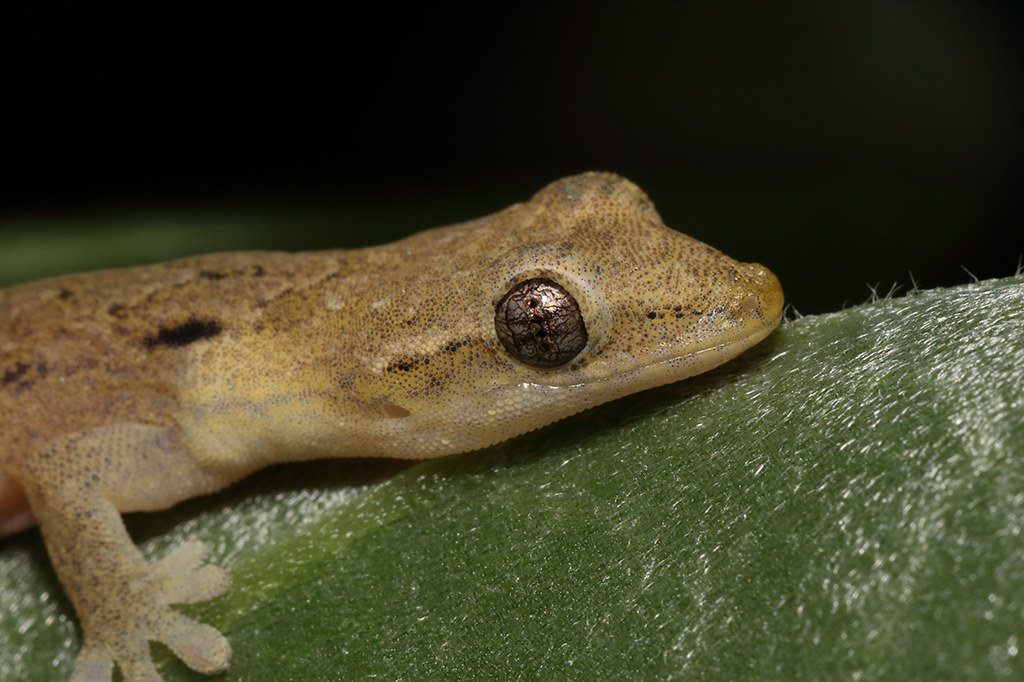Mourning geckos (Lepidodactylus lugubris) are tiny, arboreal lizards widespread across a variety of islands along the Indo-Pacific coast. Although they are quite adaptable, their preferred habitat is temperate rainforest.
Mourning geckos have tapered snouts, rounded bodies, a plump tail with small lateral spines, and sticky toe pads. Their base color is tan with a pale belly and dark markings down their back. These markings can vary by locality.
Mourning geckos are particularly unique among reptiles because they reproduce via parthenogenesis, which means that the species is entirely female, and they can produce viable eggs without mating with a male. This introduces some unique considerations for their care. Although they are otherwise fairly easy to care for, these are intermediate-level pet reptiles.
Minimum terrarium size for mourning geckos
The absolute minimum terrarium size for housing a pair of mourning geckos is 12”L x 12”W x 18”H. Of course, larger is always better, and if you don’t have a method of controlling their population, you will need to upgrade to a larger enclosure within a couple of years.
Unlike most reptiles, mourning geckos are a social species that typically live in family groups with an organized social structure. This means that they should never be housed alone.
Do mourning geckos need UVB?
Yes! Because they’re constantly producing eggs, mourning geckos need extra help from access to appropriate UVB lighting. The best UVB bulb for mourning geckos housed in a 12” x 12” x 18” terrarium is the 26w Zoo Med Reptisun 5.0 Compact Coil bulb. However, you will need a larger UVB bulb for a larger enclosure.
For best results, house the UVB bulb in a reflective fixture. Position the lamp on the same side of the terrarium as the heat lamp. UVB is blocked by glass and plastic, so placing the terrarium in front of a window doesn’t count as “free UVB” — in fact it can make your terrarium too hot due to the greenhouse effect. Don’t forget to replace your bulb every 12 months!
Lights should be kept on for 12 hours/day.
Best temperature for mourning geckos
Despite the popular myth that mourning geckos are “room temperature pets,” they do benefit from having a low-temperature basking area. After all, they’re still reptiles, and that means they need a range of temperatures in their enclosure that allow them to thermoregulate.
Mourning geckos should have a low basking temperature between 82-85°F, as measured by a digital probe thermometer with the probe positioned in the basking area. The cool zone of the enclosure should stay between 70-75°F, and nighttime temps can drop as low as 65°F.
Provide heat for your geckos with a low-wattage incandescent bulb. White heat bulbs are the best way to imitate the warmth of sunlight indoors, and considered to be a superior form of reptile heating by experts. Avoid ceramic heat emitters (CHEs), red bulbs, or blue bulbs, as these are not as effective. If the bulb is still too hot, use a plug-in lamp dimmer to reduce the heat output.
Mourning geckos have a tendency to climb upside-down the mesh at the top of their terrarium, so you will need to raise the heat lamp at least 1-2” above the mesh with a lamp stand or shims to prevent direct contact.
Best humidity levels for mourning geckos
Mourning geckos are a tropical species, so the humidity inside their enclosure should be fairly high: 60-80%. Humidity should be measured via digital probe hygrometer, with the probe placed in the middle of the terrarium.
Increase humidity by misting your geckos’ enclosure 1-2x/day with a spray bottle. Mist first thing in the morning and then again at night if needed. Aside from raising humidity, this also provides your geckos with an important source of drinking water!
Best substrate for mourning geckos
Providing a layer of naturalistic substrate (“bedding”) will help maintain correct humidity levels and also helps make your enclosure more attractive! We recommend the following substrates for mourning geckos:
Layering clean, chemical-free leaf litter on top of the substrate can also help with humidity.
Substrate should be at least 2” deep and completely replaced every 3-4 months. Remove poop and urates daily, along with contaminated substrate.
How to decorate a mourning gecko terrarium
An empty terrarium makes for bored mourning geckos, reducing their quality of life. You will also see fewer natural behaviors from them, which makes them less interesting to watch. Keep your pets entertained and engaged with its environment with the strategic use of décor items.
Since mourning geckos are arboreal, at bare minimum you will need a branch for your geckos to climb and bask on and some live or artificial foliage for them to hide in. However, it’s best to include plenty of other items, such as:
- more branches
- vines
- ledges
- live or artificial plants
What to feed to a mourning gecko
Mourning geckos are omnivores, which means that they need to eat both plant- and animal-based foods to get the right nutrition. In the wild, they primarily eat insects, nectar, and fruit. As pets, it’s best to feed them high-quality, specially-formulated crested gecko diet (CGD) supplemented by live insect feeders.
Mourning geckos do well on a diet of crested gecko diet (replaced every 24-48 hours) and calcium-dusted insects 1-2x/week. Crested gecko diet should be offered in a small cup mounted on the wall of the enclosure, rather than the floor, as this makes it more accessible.
Best crested gecko diets: Pangea, Repashy, Leapin’ Leachie, Zoo Med, Lugarti, Black Panther Zoological, Gecko Pro
Feeder insects for mourning geckos: newborn dubia roach nymphs, newborn discoid roach nymphs, red runner roach nymphs, pinhead crickets, fruit flies, hatchling snails
The key to balanced nutrition is variety, so make sure to offer a rotation of as many different foods as possible.
Supplements
You will also need a calcium supplement. We recommend Repashy Supercal NoD, lightly dusted on all feeder insects. It’s okay to occasionally skip a dusting.
Water
Of course, don’t forget small food and water bowls and a feeding ledge! Since crested geckos are arboreal, they prefer to eat and drink up off the ground. Change the water daily and scrub the bowl with a reptile-safe disinfectant weekly, or whenever it becomes soiled.
How to handle your mourning geckos
"Mourning Gecko (Lepidodactylus lugubris)" by patrickkavanagh is licensed under CC BY 2.0











